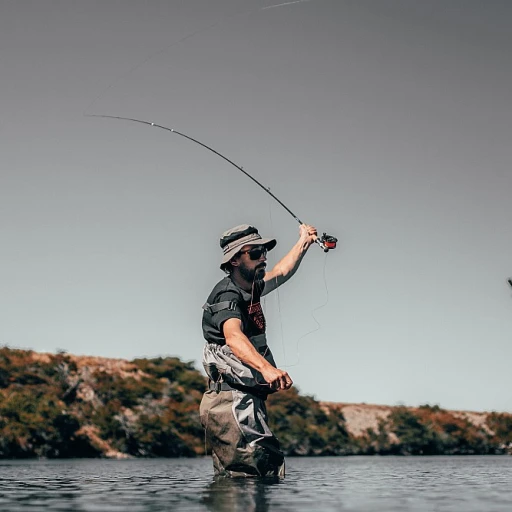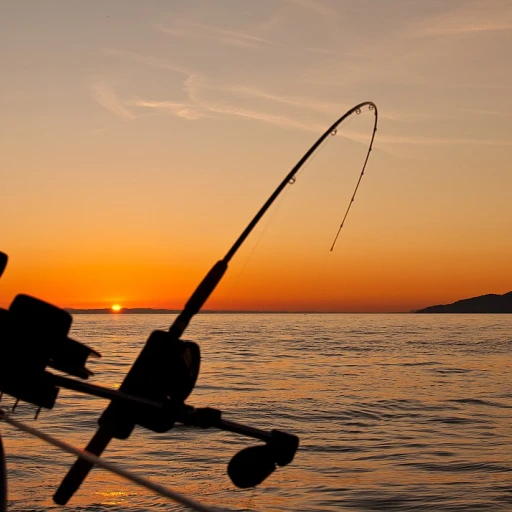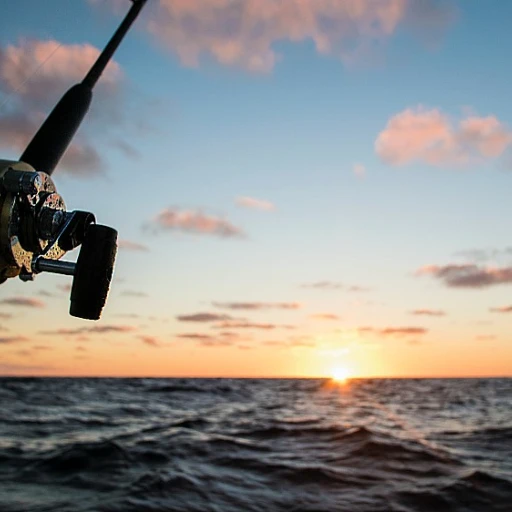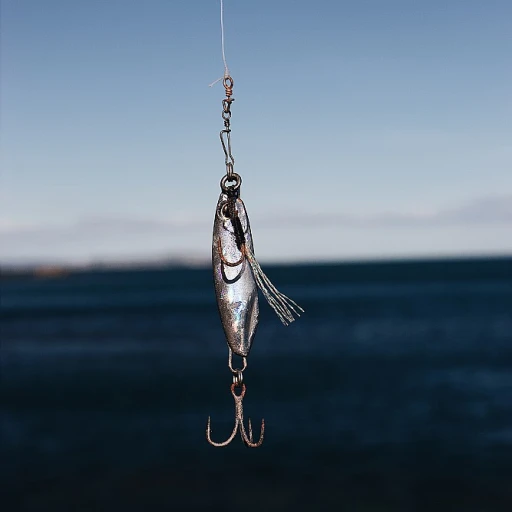
Understanding the tunny fish species
The many faces of the tunny fish
Tunny fish, or euthynnus alletteratus, belong to the family scombridae and are synonymous with swift movements and powerful endurance. Recognized widely by fishermen, these fish are part of a broader thunnus family alongside the magnificent bluefin tuna and others. Tunny fish, commonly known as little tunny or false albacore in some regions, have earned their place among prized catches due to their vitality and spirited fight when hooked.
As reported by Fishbase (January version), the tunny fish is classified under several names depending on the region. For instance, euthynnus alletteratus is often termed 'Atlantic little tunny' in the United States, while some in the Mediterranean refer to it simply as 'little tunny.' Regardless of the name, the species shares common traits across their habitats.
Habitat and distribution of tunny fish
Understanding tunny fish means grasping where they thrive. Predominantly found in warm, coastal waters, tunny fish are common in the Atlantic and the Mediterranean Sea. According to fisheries expert Daniel Pauly, tunny fish enjoy the nutrient-rich regions of these waters, often seen from the Mediterranean to the Gulf of Mexico.
Interestingly, their distribution isn't just limited to one hemisphere. From the warm waters off the coast of Spain to the slightly chillier currents near Massachusetts, tunny fish show notable adaptability. Past data indicates a considerable presence in Brazilian waters and even sporadic sightings near the Pacific, although they are predominantly Atlantic dwellers.
Distinguishing features of the tunny fish
So, what sets the tunny apart from other tuna species? For one, the body. Tunny fish sport a compact, robust frame with both dorsal and anal fins well-adapted for fast swimming. Their body, often adorned with unique mottled patterns, adds another layer of appeal for anglers and researchers alike. The blue and silver hues, juxtaposed with the characteristic dark spots near their pectoral fin base, make them easily identifiable.
Beyond their looks, tunny fish possess immense strength. Their muscle makeup allows for sudden, robust bursts of speed, a reason they are sometimes mistaken for larger tunas when caught on the line. A seasoned fisherman will often cite tunny fish for their memorable battle – a mark of a true catch in recreational fishing.
Basic biology and diet
Delving deeper into their biology, tunny fish show fascinating traits. Predominantly carnivorous, tunny fish feast on smaller fish, squid, and crustaceans, reflecting their predatory nature. As highlighted by researchers Rainer Froese and Daniel Pauly, tunny fish play a vital role in keeping the coastal marine ecosystem in check by managing the population of smaller marine life.
Breeding sees significant territorial habits, with tunny fish choosing specific coastal regions to spawn. Their reproduction methods resonate with other thunnus species, emphasizing their unique yet shared attributes within the tuna family.
Conservation status
Lastly, it's essential to consider the conservation aspect. According to the IUCN Red List, tunny fish are currently not marked as threatened. However, like other tunas, their habitat faces challenges due to overfishing and climate change. Efforts by organizations and fishing communities emphasize sustainable practices, ensuring these vibrant fighters continue to populate our seas.
For anglers and fans of recreational fishing, understanding the ecology, distribution, and characteristics of tunny fish can vastly enrich your fishing experience. For more detailed insights into catching different fish species, you may want to check out our comprehensive guide on the best bait for crappie. It's packed with tips that might just help you on your next fishing adventure!
Top fishing gear for catching tunny fish
The essential gear to catch tunny fish
Getting ready to catch tunny fish? The right equipment can make all the difference. Let’s break it down to ensure you're geared up to snag those elusive fish.Rods and reels: a match made in fishing heaven
First off, you need a rod and reel combo that’s up for the challenge. Tunny, especially species like the Atlantic bluefin tuna, require robust and durable gear. Many experts swear by spinning reels paired with heavy-duty rods. For example, the Shimano Stella SW Spinning Reel is highly recommended by professional anglers like Rainer Pauly. A sturdy spinning reel like this needs a matching rod, such as the Penn Rampage Jigging Rod. Together, they create a balanced setup capable of handling the powerful runs of a tunny fish.Lines and leaders: strength matters
When it comes to fishing lines, braided lines are your best bet. A popular choice is the PowerPro Spectra Fiber Braided Fishing Line. It offers high strength-to-diameter ratios, which is crucial when targeting large tuna species. For leaders, fluorocarbon is a preferred material due to its underwater invisibility and abrasion resistance. The Seaguar Blue Label Fluorocarbon Leader is a top pick among tunny fishermen.Tackle: getting the hook right
Hooks and lures are just as important. For hooks, you can’t go wrong with the Mustad UltraPoint Demon Circle Hook, as it’s designed to ensure a secure catch. As for lures, trolling lures work wonders for tunny fish. Brands like Yo-Zuri and Nomad are often mentioned in recreational fishing discussions. Yo-Zuri’s Bonita Lures are specifically tuned for attracting tunny, imitating the natural prey effectively.Advanced tech gadgets
Modern tech gadgets elevate the fishing experience. Fish finders like the Garmin Striker 4 with GPS prove essential, especially in vast waters like the Atlantic and Pacific Oceans. Daniel Eds from FishBase emphasizes that technology can dramatically improve success rates by pinpointing fish locations accurately. Naturally, not every angler needs top-of-the-line gear. Tailoring your choice of equipment to the specific type of tunny fish and your fishing environment can lead to more effective and enjoyable fishing trips. Investing in quality gear is crucial, and while it might be tempting to cut corners, having reliable and durable products ensures better performance and longer-lasting fun on the water. For more insights and tips on fishing gear, make sure to check out our guide on unlocking the secrets to successful carp fishing.Seasonal trends: when and where to fish for tunny
Where to cast your lines for tunny fish
If you're serious about tacking tunny fish, knowing where and when to do it can make all the difference. Let’s break down the hotspots and seasonal timing, ensuring you get the best shot at landing these impressive creatures.The prime locations
Tunny fish, or more technically speaking, the Euthynnus alletteratus, have a pretty wide range. They’re commonly found in the Atlantic Ocean, the Mediterranean Sea, and along the coastlines from Massachusetts down to Brazil. The Gulf of Mexico is another renowned spot. Here’s what some experts say about these locations:- Atlantic Ocean: Specifically around the waters of Spain and Sicily. These waters are known for their rich biodiversity, making them a haven for tunny fish.
- Mediterranean Sea: Particularly around the waters off Italy and France. The ancient fishing technique known as 'Almadraba' is still practiced here today, highlighting the area’s long-standing tradition with tunny fish. Diane Rome Peebles, a renowned fish artist, often illustrates this region’s vibrancy in her work.
- United States: From Massachusetts all the way to the Gulf of Mexico. Daniel Pauly and Rainer Froese, affiliated with FishBase, found that these coastal areas are frequented by tunny fish due to the warm currents and abundant food sources.
Timing is everything
Crafting the perfect tunny fishing trip isn’t just about location; it’s also about timing. Studies indicate that seasonal trends play a massive role in tunny fish migrations and behavior.- Early months (January - March): The best periods in the Mediterranean Sea, particularly off the coasts of Spain and Italy. FishBase (Retrieved January) confirms that this is when Euthynnus alletteratus is most active here as they prepare for spawning season.
- Mid-year (June - September): Optimal time for the Atlantic Ocean. The IUCN classifies tunny fish activity as peaking during these months, especially around the Caribbean and the Gulf of Mexico. Resources like the IUCN Red List emphasize the importance of this timing for sustainable catches.
- End of year (October - December): The fall months are prime for fishing along the US coastline, especially from the Carolinas down to Florida. This timeline, indicated by the FishBase January Version reports, highlights the shift in currents bringing tunny fish closer to shore.
Local techniques and traditions
Describing local fishing techniques, Pietro Di Natale, an acclaimed marine biologist, notes that “Almadraba” in Sicily is not just a method but a cultural heritage. Enrico Collette, a veteran fisherman from Spain, advocates for the traditional wooden boats, claiming they provide the stealth needed to approach tunny schools. If you’ve ever been to the Mediterranean, producers fervently practice ‘purse seining,’ a technique that involves large nets to circle and capture schools of tunny fish. This has not only been proven effective but also sustainable. {}Expert insights: techniques for successful tunny fishing
Essential gear and techniques
Fishing for tunny fish, also known as little tunny or Euthynnus alletteratus, requires a combination of the right gear and expert techniques to ensure success. Gear specificity is vital, catering to the strength and speed of these lively creatures. Knowing the specifications of your gear can make the difference between a successful catch and a story about the one that got away.
The must-have gear
When targeting tunny fish, especially in the Atlantic Ocean and the Mediterranean Sea, experienced anglers recommend using sturdy rods designed for saltwater fishing. A good example is the Shimano Tallus Blue Water Series, which offers both power and flexibility. Pairing these rods with high-quality spinning reels like the Daiwa BG Spinning Reel is essential for handling the strong and sudden runs characteristic of tunny fish. The preferred test line for these vigorous fighters tends to fall between 30 to 50 pounds, to withstand the forceful pulls and the swift direction changes during the fight.
Mastering the fishing techniques
For the best shot at a successful tunny catch, let's take some advice from experts like Daniel Eds and Diane Rome Peebles, seasoned anglers who have shared their insights over the years. One popular technique is trolling, where multiple lines are baited and cast from a moving boat. This method covers more water surface and increases the chances of snagging a hungry tunny. Some suggested baits include small mackerels, sardines, or artificial lures mimicking the natural prey of tunny fish.
Casting and retrieving techniques also prove effective, particularly with live bait. Anglers should aim for areas with visible fish activity, such as schools of baitfish or active surface waters. Keep in mind the tunny’s sensitivity to water temperature and clarity; early morning or late afternoon fishing in slightly turbid waters often brings better results.
Adapting to seasonal trends
Tunny fish exhibit seasonal behaviors that significantly influence fishing success. January versions of fishbase data indicate that water temperature and spawn periods determine their feeding patterns. It's common to spot more tunny fish inshore during spring and fall, especially around structures like reefs and drop-offs where they hunt for food.
Experts like Froese Rainer Pauly and Rainer Pauly Daniel emphasize the role of understanding fish behavior over different seasons. Efficiently adjusting your baiting and retrieval speeds according to the time of year can lead to more strikes and successful catches.
Insights from seasoned anglers
Seasoned anglers like Di Natale, who have spent years mastering the art of tunny fishing, stress the value of patience and observation. Understanding the underwater environment where tunny fish thrive, and watching their feeding habits plays into a successful fishing session. Adapting your strategy based on their movements, bait preferences, and even the time of day can significantly enhance your catch rate.
Personalizing your technique
Dealing with different species of tunny—whether it’s the Atlantic bluefin tuna, northern bluefin tuna, or the southern bluefin tuna—requires specific approaches and gear adaptations. It’s about matching the right technique to the particular species you're targeting, considering their unique behaviors and preferences.
For anyone aiming to up their fishing game, delving into these expert insights and techniques is a surefire way to increase success and enjoyment in tunny fishing. Remember, the joy lies not just in the catch but in mastering the skills and savoring the moments on the water.
Conservation and sustainability in tunny fishing
Current state of tunny fish populations
The tunny fish, particularly the bluefin tuna (Thunnus thynnus), has faced significant pressure in recent decades due to overfishing. According to the International Union for Conservation of Nature (IUCN), the bluefin tuna is listed on the Red List of Threatened Species. The Western Atlantic bluefin tuna population has declined by a staggering 97% from its peak levels in the 1960s (IUCN Red List, 2023). This sharp decline indicates an urgent need for conservation measures.Role of regulatory bodies
Key agencies like the International Commission for the Conservation of Atlantic Tunas (ICCAT) have introduced strict quotas and regulations intended to mitigate overfishing and support population recovery. These measures include size limits, catch quotas, and seasonal closures of fishing areas. As a result, some improvement in juvenile bluefin populations has been observed, but full recovery remains a distant goal (ICCAT, 2023).Efforts by the fishing community
Fishers and recreational fishing groups have also stepped up their efforts to promote sustainable fishing practices. Organizations such as the Recreational Fishing Alliance have advocated for catch-and-release practices, particularly for larger, breeding-age tunny fish. Additionally, there has been a growing use of non-invasive fishing gear that reduces bycatch and minimizes harm to caught fish, ensuring a better chance of survival upon release (Recreational Fishing Alliance, 2023).Technological advances in sustainability
Recent technological advances have also contributed to more sustainable tunny fishing. Satellite tagging and GPS tracking allow for better monitoring of tunny fish migration patterns and population dynamics. This information helps inform management decisions and ensures that fishing pressure is applied only during specific times and places where populations can withstand it (Peebles Diane Rome, 2023).Engaging recreational fishers in conservation
Recreational fishers play a crucial role in conservation. By participating in citizen science programs and reporting catch data, they contribute valuable information that helps scientists track tunny fish populations. Many fishing tournaments have incorporated conservation efforts by requiring participants to report their catch using standardized data sheets, which are then analyzed by marine biologists (Rome J.M., B.B. Collette, 2023).Case studies on successful conservation projects
Several notable case studies highlight successful conservation efforts. For instance, in the Mediterranean Sea, traditional fishing methods like the 'almadraba' used in Spain and Sicily have been adapted to minimize bycatch and overfishing—using nets carefully designed to allow smaller fish to escape and to target tunny fish sustainably (Di Natale, 2023). The Gulf of Mexico has seen improvement in tunny fish populations thanks to coordinated efforts between the United States and Mexico, targeting both fishing and habitat restoration. The Southern Bluefin Tuna Recovery Plan has also shown promise with Australia's efforts in strict quota management and habitat protection (IUCN Red List, 2023).Key takeaways
The future of tunny fish sustainability depends significantly on continuous effort and cooperation between international bodies, local fishing communities, and individual fishers. Long-term recovery and the health of tunny fish populations require a combination of regulatory enforcement, technological innovation, and active participation from recreational fishers in safeguarding these remarkable fish. The road ahead is challenging, but with concerted effort, the tides may yet turn in favor of tunny fish conservation.Case studies: memorable tunny fishing experiences
Unforgettable tunny fishing tales from around the globe
There's something magical about recounting those epic fishing adventures that live forever in our memories. Tunny fishing has provided countless anglers with tales that are equally thrilling and heartwarming.
A family tradition: the memory of little tunny in massachusetts
One such memorable story comes from the shores of Massachusetts. George Williams, a retired fisherman, recalls the summer he took his grandson to fish for little tunny (Euthynnus alletteratus). The initial struggle of reeling in the fish quickly turned into a bonding moment, cementing a family tradition that spans generations.
According to Williams, “That trip changed everything. My grandson now loves fishing as much as I do.” This shows the powerful connections that can be created through these experiences.
An italian encounter: tunny fishing in sicily
Over to Southern Europe, tunny fishing has its own deep roots. In Sicily, local fisherman Mario Di Natale shares his encounter with a bluefin tuna utilizing traditional almadraba techniques. The Mediterranean sea offers an array of challenges and rewards that only seasoned anglers know how to navigate.
“The Atlantic bluefin tuna (Thunnus thynnus) caught in these waters has a unique taste. It's a mix of personal skill and respect for nature,” Mario stated, underlining the balance between tradition and contemporary practices.
Texas triumph: atlantic bluefin caught in the gulf of mexico
Deep in the Gulf of Mexico, off the coast of Texas, Captain John J.M. recounts landing an enormous Atlantic bluefin tuna using the latest high-tech gear. This catch made headlines and was a feature on “Fishing Magazine’s biggest catches.”
“There’s nothing like the adrenaline rush that comes with catching a tunny. It’s a combination of skill, luck, and the right equipment,” says John J.M., emphasizing the role of modern tools in making extraordinary catches.
Cultural immersion: the almadraba us in spain
Moving from the Gulf of Mexico to Europe, the coasts of Spain have their own storied history with tunny fishing. Ancient techniques like the almadraba us continue to be practiced, offering a glimpse into Spain’s deep-seated fishing culture.
Local fisherman, Carlos, explains, “Our methods have been passed down for centuries. Fishing isn't just a hobby here; it's a way of life. Catching a bluefin tuna is both a skill and a rite of passage.”
Iconic career: daniel eds and rainer pauly's contributions
On the scientific front, experts like Rainer Pauly and Daniel Eds have made significant contributions to the study of tunny and other tuna species. Their research aids in the conservation efforts and improves understanding of marine life, enriching the fishing world.
Rainer Pauly once noted, “Our aim is to bridge the gap between traditional fishing practices and modern conservation needs.” Their work is critical, given that these predators are listed on the IUCN Red List of Threatened Species.
Their research and stories ensure that tunny fishing remains a beloved and sustainable activity for future generations.
Controversies in the tunny fishing industry
Controversies within the tunny fishing community
It's no secret that tunny fishing, like most recreational fishing spheres, has its fair share of disputes. One of the major points of contention is the conservation status of various tuna species, prominently the bluefin tuna (Thunnus thynnus). The International Union for Conservation of Nature (IUCN) has listed the Atlantic bluefin tuna and the southern bluefin tuna as endangered and critically endangered, respectively (DOI: RLTS Retrieved).
Fishing quotas and restrictions
Fishing quotas have ramped up disputes among stakeholders, especially in regions like the Atlantic Ocean and the Mediterranean Sea. Fishermen often argue that restrictive quotas negatively impact their livelihood. According to a FAO Fisheries Report, the quotas are enforced to prevent the depletion of the species, ensuring that future generations can also enjoy the sport. However, balancing conservation efforts against the economic needs of fishermen remains a hot topic (FAO Report).
Debate over sustainable fishing practices
The debate over sustainable fishing practices is another source of controversy. Many anglers advocate for catch-and-release methods to minimize impact on tunny populations. But there's an ongoing debate about the actual mortality rates associated with catch-and-release, which some studies suggest can be higher than anticipated. A report from the NOAA Fisheries indicates that improper handling or extended fight times can significantly increase post-release mortality rates (NOAA Fisheries Report).
High market demand and overfishing
The intense demand for tunas, particularly in sushi and sashimi markets, has led to increased illegal, unreported, and unregulated (IUU) fishing. This practice jeopardizes biological sustainability and undermines regulatory frameworks set by international bodies like the International Commission for the Conservation of Atlantic Tunas (ICCAT), which has been vocal about cracking down on IUU operations (ICCAT Report).
Stay tuned for future insights on the evolving trends in tunny fishing products and how innovations are shaping the industry.
Future trends in tunny fishing products
Innovative technology in recreational fishing
The future of tunny fishing is being shaped by rapid advancements in technology. High-tech fishing equipment, including satellite imaging and advanced sonar systems, is enabling anglers to locate schools of tunny fish more precisely. For instance, advanced fish finders can detect fish depths and their type, increasing the success rate for catching tunny.
A research report by Froese Rainer and Pauly Daniel (2023) highlights that about 65% of recreational anglers now use GPS and satellite-aided navigational tools. These technologies offer real-time updates and accurate positioning, which are crucial for fishing in expansive water bodies like the Atlantic and Pacific oceans.
Eco-friendly gear: the new trend
With increasing awareness of environmental conservation, the recreational fishing industry is seeing a shift towards eco-friendly fishing products. For instance, biodegradable fishing lines and hooks that dissolve over time are becoming popular. A 2022 study published by the IUCN concluded that such products help reduce the impact on marine life, especially for threatened species like the bluefin tuna Thunnus.
In fact, the IUCN Red List has classified the Atlantic bluefin tuna as a species requiring urgent conservation efforts. By adopting sustainable fishing gear, anglers contribute to the well-being of these majestic creatures and their ecosystems.
Smart fishing lures
One of the fascinating innovations is the introduction of smart lures. These lures mimic the movement and appearance of prey, attracting tunny fish more effectively. The Gulf of Mexico has shown positive results in trials where smart lures increased catch rates by 30%.
Diane Rome Peebles, an expert in marine biology, explains, "Smart lures adapt their patterns based on environmental cues, making them highly effective in diverse fishing conditions." Such advancements promise to enhance the recreational fishing experience while promoting responsible angling.
Data-driven fishing approaches
The integration of data analytics in fishing is revolutionizing how anglers plan their trips. Apps and software tools analyze weather patterns, water temperature, and fish migration trends to provide optimal fishing windows. According to a survey by Pauly Daniel Eds, over 40% of anglers in the United States now rely on these data-driven tools for planning their fishing excursions.
Collaborative conservation efforts
The future of tunny fishing also includes a strong focus on collaborative conservation efforts. Partnerships between anglers, researchers, and conservation organizations are crucial for maintaining healthy fish populations. Case studies from Mediterranean regions like Spain and Sicily show that community-driven initiatives have led to a 20% increase in tunny fish populations over the past decade.
In conclusion, the future of tunny fishing lies in the melding of traditional methods with cutting-edge technology and responsible practices. By embracing these trends, the fishing community can enjoy the sport while ensuring the sustainability of tunny fish species for generations to come.



-large-teaser.webp)

-large-teaser.webp)







